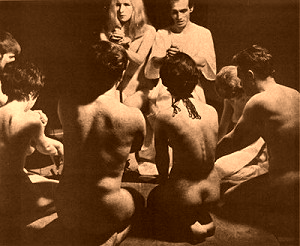Wicca is a new Pagan religious movement that draws upon both ancient and 20th-century models for its theological structure and ritual practices.
It was developed in England during the first half of the 20th century and was introduced to the public in 1954 by Gerald Gardner, a retired British civil servant.
Wicca has no central authority figure. Its traditional core beliefs, principles, and practices were originally outlined in the 1940s and 1950s by Gardner and an early High Priestess, Doreen Valiente. Gardner claimed an un-broken tradition back to medieval times. The early prac-tices were disseminated through published books and in oral teachings passed along to their initiates. The religion has grown and evolved over time. It is divided into a number of diverselineages, denominations, referred to as traditions, each with its own organisational struc-t ure and level of entralization.
Some traditions, collectively referred to as Tradi-tional Wicca, strictly follow the initiatory lineage of Gardner and think the term Wicca to apply only to simi-
 Skyclad
Wiccans
Skyclad
Wiccans
lar traditions, but not to other traditions.
Wicca is typically duotheistic,
with a Goddess and a God, traditionally viewed as the Triple
Goddess and
the Horned
God,
respectively. They are sometimes referred to as the "Great Goddess" and
the "Great Horned God", with the adjective "great" signifying a deity
that contains many other deities within their own nature. Some Wiccans
refer to the goddess deity as the "Lady" and the god deity as the
"Lord". These two deities are sometimes viewed as aspects of a greater pantheistic divinity,
which is regarded as an impersonal force or process rather than a
personal deity. While duotheism is
traditional in Wicca, broader Wiccan beliefs range from polytheism to pantheism or monism,
even to Goddess
monotheism.
Wiccan celebrations encompass both the cycles of the Moon, known as Esbats and commonly associated with the Goddess, and the cycles of the Sun, seasonally based festivals known as Sabbats and commonly associated with the Horned God. An unattributed statement known as the Wiccan Rede is a popular expression of Wiccan morality, although it is not universally accepted by Wiccans.
Many Wiccans remain skeptical about the supernatural but remain involved in Wicca because they love its rituals: These rites often include a special set of magical tools. These usually include a knife called an athame, a wand, a pentacle and a chalice, but other tools include a broomstick known as a besom, a cauldron, candles, incense and a curved blade known as a boline. An altar is usually present in the circle, on which ritual tools are placed and representations of the God and the Goddess may be displayed Before entering the circle, some traditions fast for the day, and/or ritually bathe. After a ritual has finished, the God, Goddess, and Guardians are thanked, the directions are dismissed and the circle is closed.
A central aspect of Wicca (particularly in Gardnerian and Alexandrian Wicca), often sensation-alised by the media is the traditional practice of working in the nude, also known as skyclad. Many Wiccans believe that performing rituals skyclad allows "power" to flow from the body in a manner unimpeded by clothes. Some also say that the practice removes signs of social rank and thus encourages unity among the practitioners.
Other traditions wear robes tied at the waist or even street clothes. In certain traditions, ritualized sex magic is performed in the form of the Great Rite, during which the High Priest and High Priestess perform sexual intercourse to raise magical energy. In many cases they have surrendered to Christian morality and, instead the Great Rite is done merely symbolically, using the athame to symbolise the penis and the chalice to symbolise the womb.